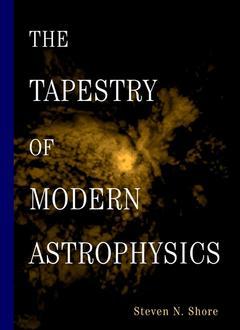Description
The tapestry of modern astrophysics
Author: SHORE Steven N.
Language: English
Approximative price 104.12 €
Subject to availability at the publisher.
Add to cart
Publication date: 09-2002
896 p. · 26.1x18.3 cm · Hardback
896 p. · 26.1x18.3 cm · Hardback
Description
/li>Contents
/li>
The scope of modern astrophysics is the entire cosmos and everything in it. As and substantial as its subject, The Tapestry of Modern Astrophysics provides advanced undergraduates or graduate-level students with a comprehensive introduction to the subject. Avoiding axiomatic presentations, the author combines extensive qualitative discussions with analytical treatments so that students develop physical intuition-the combination of observations and theoretical "horse sense" that is necessary for research in the field. The text is particularly distinguished by its deep and broad coverage, showing the way apparently different parts of astrophysics are intimately connected. Emphasizing the physical basis of the astrophysical phenomena along with the interpretation of data, Shore covers: The physical processes common to all cosmic bodies-gravitation, thermal physics, and the gas laws. Special topics include statistical mechanics of stellar systems, rate equations, and General Relativity Overview of instrumentation and data analysis methods including calibration, instrumentation, and image formation and reconstruction Radiative transfer and physical processes in stellar and planetary atmospheres. Special topics include spectral classification and techniques for treating scattering Stellar structure and evolution, energy sources, and nucleosynthesis The interstellar medium with a general introduction to radiative and hydrodynamical processes The Milky Way as a galaxy, emphasizing the connection between locally observed phenomena and broader properties of extragalactic systems, active galaxies, and clusters of galaxies Cosmology and structure formation STEVEN N. SHORE is Professor of Physics and Astronomy at Indiana University South Bend. He is a scientific editor of the Astrophysical Journal and a visiting professor at Osservatorio Astrofisico di Arcetri, University of Pisa, University of Notre Dame, and Arizona State University. He is the author of An Introduction to Astrophysical Hydrodynamics.
Preface.Chapter 1. From Gases to Clusters: Concepts in Gravitation and Gas. Chapter 2. The Raw Materials: Instruments and Observations. Chapter 3. Radiative Transfer and the Outer layers of Stars. Chapter 4. The Interiors of the Stars and Stellar Evolution. Chapter 5. Structure and Evoltuion of Close Binary Stars. Chapter 6. The Interstellar Medium. Chapter 7. Our Galaxy and Others as Stellar Systems. Chapter 8. The Biggest Picture: Cosmology.Index.
© 2024 LAVOISIER S.A.S.




